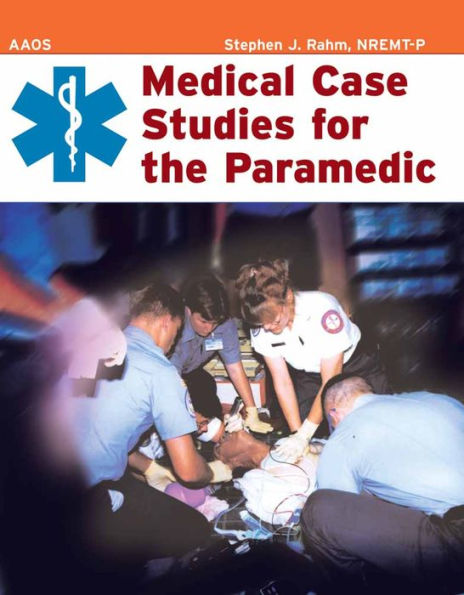Medical Case Studies for the Paramedic: .
Paramedics must perform a systematic assessment of the patient, determine appropriate treatment, and give it. While assessment and management principles are learned in initial training, they are not practiced until training is completed. Now, paramedic students can apply these principles with Medical Case Studies for the Paramedic. Medical Case Studies for the Paramedic presents 20 case studies on the most important medical emergencies for the ALS-level reader. A superb supplement to classroom and textbook learning, this book allows the reader to practice applying knowledge to cases before actually going on an emergency call. The types of emergencies include a range of presentations such as semiconsciousness, unconsciousness, difficulty breathing, weakness, nausea, headache, slurred speech, chest pain, allergic reaction, seizure, and anxiety. Each case study is presented in full, poses questions to the reader, and is followed by a summary of the case, including answers to the questions posed. The objectives for each of the case studies in this book are as follows: Describe the appropriate initial management based on initial assessment findings. Interpret the patient’s cardiac rhythm, and determine if a correlation exists between the patient’s condition and their cardiac rhythm. Formulate a field impression based on the patient’s signs and symptoms, and findings of the focused history and physical examination. Determine if the patient’s vital sign values and SAMPLE history findings are consistent with your field impression. Identify specific treatment that is required for the patient’s condition. Determine if further treatment is required following a post-treatment reassessment of the patient. Based on the patient’s condition, identify any special considerations for care. PARAMEDIC Review of all basic level skills and an introduction to advanced skills of the paramedic. Topics include roles and responsibilities, stress management, communications and medical/legal/ethical issues. This course provides an introduction to clinical pre-hospital pharmacology, IV access and advanced airway management techniques. Lab work involves IV access techniques, endotracheal intubation, computing dosages, preparing medications for administration and practice in all administrative techniques. Skills are taught/practiced in the laboratory/hospital/field setting. Students must satisfactorily perform all practical skills to successfully complete the course. © 2004 | 196 pages
1147782819
Medical Case Studies for the Paramedic: .
Paramedics must perform a systematic assessment of the patient, determine appropriate treatment, and give it. While assessment and management principles are learned in initial training, they are not practiced until training is completed. Now, paramedic students can apply these principles with Medical Case Studies for the Paramedic. Medical Case Studies for the Paramedic presents 20 case studies on the most important medical emergencies for the ALS-level reader. A superb supplement to classroom and textbook learning, this book allows the reader to practice applying knowledge to cases before actually going on an emergency call. The types of emergencies include a range of presentations such as semiconsciousness, unconsciousness, difficulty breathing, weakness, nausea, headache, slurred speech, chest pain, allergic reaction, seizure, and anxiety. Each case study is presented in full, poses questions to the reader, and is followed by a summary of the case, including answers to the questions posed. The objectives for each of the case studies in this book are as follows: Describe the appropriate initial management based on initial assessment findings. Interpret the patient’s cardiac rhythm, and determine if a correlation exists between the patient’s condition and their cardiac rhythm. Formulate a field impression based on the patient’s signs and symptoms, and findings of the focused history and physical examination. Determine if the patient’s vital sign values and SAMPLE history findings are consistent with your field impression. Identify specific treatment that is required for the patient’s condition. Determine if further treatment is required following a post-treatment reassessment of the patient. Based on the patient’s condition, identify any special considerations for care. PARAMEDIC Review of all basic level skills and an introduction to advanced skills of the paramedic. Topics include roles and responsibilities, stress management, communications and medical/legal/ethical issues. This course provides an introduction to clinical pre-hospital pharmacology, IV access and advanced airway management techniques. Lab work involves IV access techniques, endotracheal intubation, computing dosages, preparing medications for administration and practice in all administrative techniques. Skills are taught/practiced in the laboratory/hospital/field setting. Students must satisfactorily perform all practical skills to successfully complete the course. © 2004 | 196 pages
125.95
In Stock
5
1

Medical Case Studies for the Paramedic: .
196
Medical Case Studies for the Paramedic: .
196Paperback(1E)
$125.95
125.95
In Stock

Product Details
| ISBN-13: | 9780763777722 |
|---|---|
| Publisher: | Jones & Bartlett Learning |
| Publication date: | 04/20/2009 |
| Edition description: | 1E |
| Pages: | 196 |
| Product dimensions: | 8.40(w) x 10.80(h) x 0.50(d) |
About the Author
From the B&N Reads Blog
